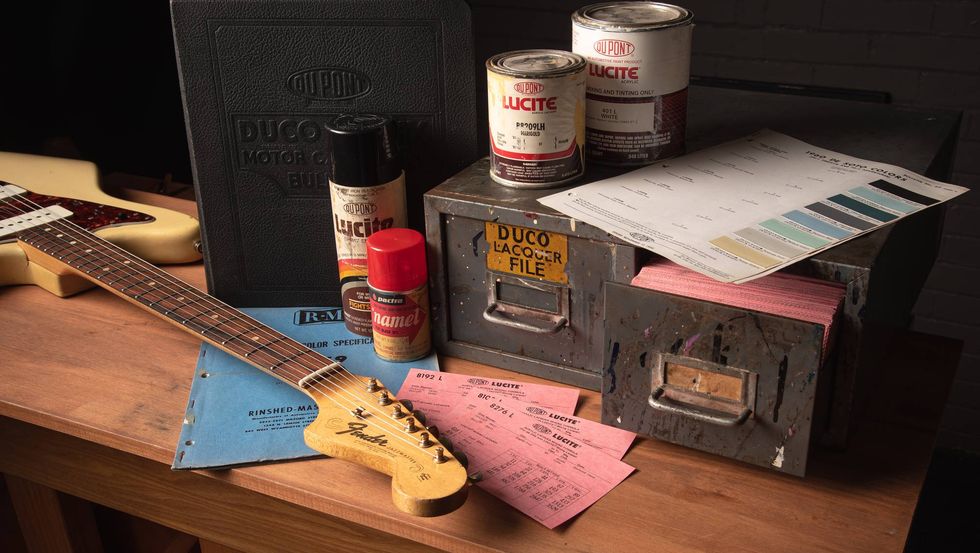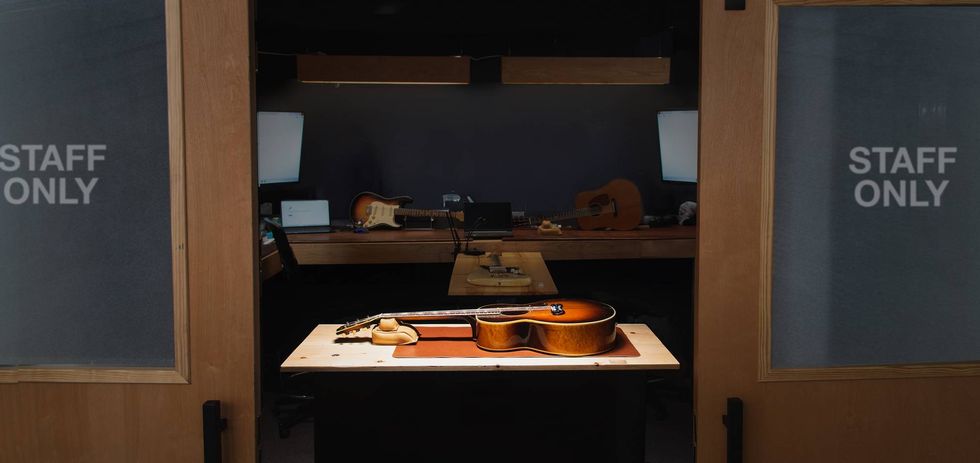A few years ago, I found out quite by accident
that when I replaced the ABR-1 bridge
on my Gibson Historic Les Paul with the
same bridge from an actual 1959 Gibson, the
tonal change was almost as dramatic as some
pickup changes I had made. The bridge
mass and material made all the difference in
the tone. I noticed that a great majority of
Gibsons were using the Nashville Tune-O-Matic
bridge. However, as many have found
out, there’s a difference in the construction of
the ABR-1 and Nashville Tune-O-Matic bridges
(installed on all post-1976 Les Pauls), since
the holes are drilled at differing widths.
When the ABR-1 was dowelled, drilled and reset properly, the tonal change was much more pronounced. There was more chime and snap when the guitar was played with fingers. The overtones were more musical and pure, and octave sustain and pick harmonics were more readily available. The Nashville bridge was more massive, and logically should have sustained better, but this was not the case. More low end was present at certain frequencies, but these seemed to diminish low-end tightness. With the ABR-1, there was all the bass anyone could ever need. As a matter of fact, it provided much more definition to the low strings for muting and fast playing.
John Brown has created a post that screws into the existing Nashville bridge anchors— offset so that lining them up to the ABR-1 bridge is a snap. Using the ABR-1 type thumbwheels vertical adjustment is possible, and installation is simple. You have only to radius and slot the bridge and you’re ready to play. Intonation can be done at this time. I do recommend having the work done by a professional if you haven’t done this before, as spacing is critical.
Brown also cleverly inserted a locking set-screw at an angle to the post (adjustable with an included Allen wrench), so there’s no play at all in the threads of the anchors, which some have felt was an issue. The posts are now machined out of a single piece of steel for more strength. I have installed these posts on many, many guitars, and never had a dissatisfied client. Everyone felt it was well worth the price of installation, and loved their new tone.
When the ABR-1 was dowelled, drilled and reset properly, the tonal change was much more pronounced. There was more chime and snap when the guitar was played with fingers. The overtones were more musical and pure, and octave sustain and pick harmonics were more readily available. The Nashville bridge was more massive, and logically should have sustained better, but this was not the case. More low end was present at certain frequencies, but these seemed to diminish low-end tightness. With the ABR-1, there was all the bass anyone could ever need. As a matter of fact, it provided much more definition to the low strings for muting and fast playing.
John Brown has created a post that screws into the existing Nashville bridge anchors— offset so that lining them up to the ABR-1 bridge is a snap. Using the ABR-1 type thumbwheels vertical adjustment is possible, and installation is simple. You have only to radius and slot the bridge and you’re ready to play. Intonation can be done at this time. I do recommend having the work done by a professional if you haven’t done this before, as spacing is critical.
Brown also cleverly inserted a locking set-screw at an angle to the post (adjustable with an included Allen wrench), so there’s no play at all in the threads of the anchors, which some have felt was an issue. The posts are now machined out of a single piece of steel for more strength. I have installed these posts on many, many guitars, and never had a dissatisfied client. Everyone felt it was well worth the price of installation, and loved their new tone.








![Rig Rundown: John 5 [2026]](https://www.premierguitar.com/media-library/youtube.jpg?id=62681883&width=1245&height=700&quality=70&coordinates=0%2C45%2C0%2C45)









![Rig Rundown: Russian Circles’ Mike Sullivan [2025]](https://www.premierguitar.com/media-library/youtube.jpg?id=62303631&width=1245&height=700&quality=70&coordinates=0%2C0%2C0%2C0)







